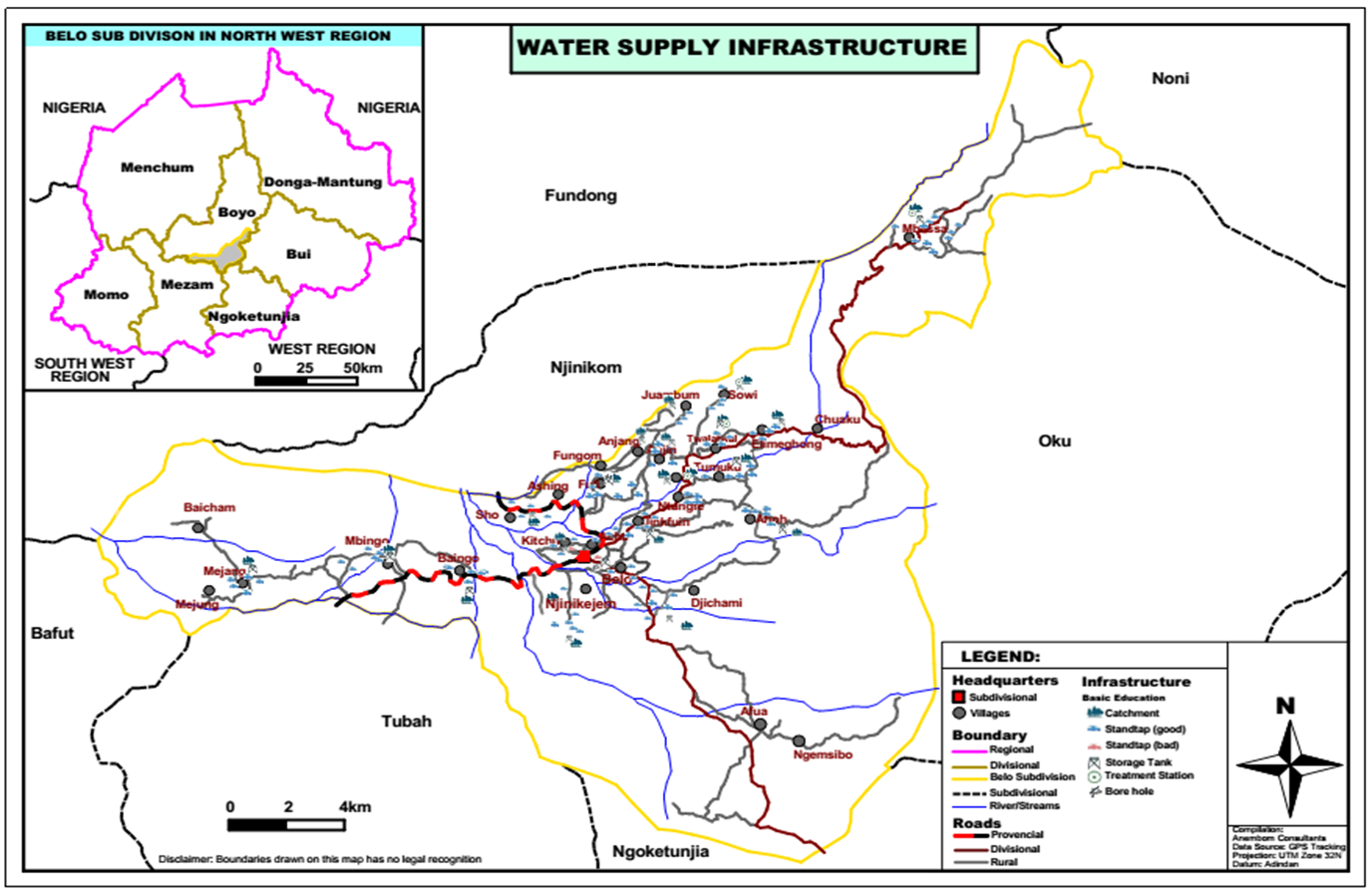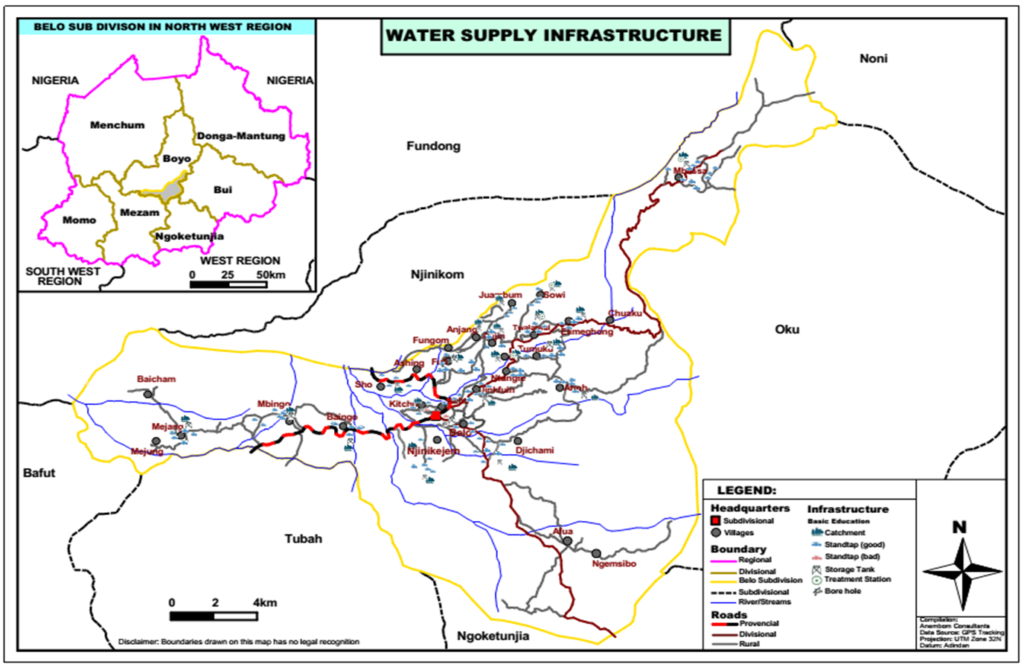The topography and relief makes it possible for the communities to have water supply through gravity. There are several underground water sources that serve as spring sources and catchment. There are a total of 25 springs were water is captured. There are a total of 335 stand taps. There are no wells in the Council area. There is a borehole constructed by SCAN WATER at Chuaku. It is no longer functional because the community could not afford to pay for fuel needed for the functionality of the water system. With the population of 88,664 and 335 standtaps, there is an estimated 264 inhabitants/ stand tap. At an aggregate, it meets the norms but however, there are some communities that have no clean water supply system. The detailed situation of water is found in the annexed report.
The tables below summarize the water situation in Belo Council area.
Table 35: Summary of functioning state of water points in the Belo Council area
| Project Type | FUNCTIONING STATE | TOTAL | ||
| Good | Damaged | To be Rehabilitated | ||
| Boreholes | 01 | 01 | 00 | 02 |
| Wells | 00 | 00 | 00 | 00 |
| Sources | 21 | 00 | 04 | 25 |
| Stand taps | 315 | 20 | 335 | |
| Etc. | 00 | 00 | 00 | 00 |
| Total | 21 | 01 | 04 | 28 |
Source :2017 field survey
Table 36: Functioning state of water points according to the milieu of residence in the Belo Council area
| MILIEU OF RESIDENCE | TOTAL POPULATION | FUNCTIONING STATE | TOTAL | ||
| GOOD | DAMAGED | TO BE REHABILITATED | |||
| Urban | 32,425 | 10 | |||
| Rural | 56,938 | 11 | 04 | ||
| Total | 89,363 | 21 | 04 | ||
Source :2017 field survey
Energy is supplied only by the official supplier of energy, ENEO. Of the 29 villages, 15 villages (52%) are connected to the national grid. There are 21 transformers and most of them are 2-face transformers. On the record, there are 963 connected officially. However, due to the high cost of connection, some inhabitants are connected illegally. Here, they connect to their homes, from those who are regularly connected and the bills are shared amongst themselves.

ENEO provides electricity to the villages in the municipality – Acha, Afua, Ashing, Anjang, Anjin, Baingo, Belo, Djichami, Elimeghong, Fuli, Jinkfuin, Kitchu, Mbingo, Njinikejem, Sowi and Twalatwal. The Rural Electrification Agency (AER) sponsored the electrification of some communities. The project stated but not completed, hence leaving the beneficiary communities in perpetual longing as they travel 6-10km to charge their mobile phones, while for the few inhabitants with generators, the purchase of fuel is exorbitant. The few communities that are benefiting from ENEO electricity are witnessing 2-3 days regular black-outs. This constant interruption coupled with low voltage slows down economic activities.
Table 37: Supply of Electricity in the Belo Council area
| Village | Population (a) | REALIZATIONS | STRUCTURE CHARACTERISTICS | FUNCTIONALITY | TRANSFORMER | |||||||||
| Enterprise | Source of financing | Fixed date | Nature | Number of transformers | Number of Connections | Functioning network | Existence of a vigilance committee | Existence of a management committee (for a decentralized electrification) | Geographic Coordinates | |||||
| (i) | (Y/N) | (ii) | Latitude | Longitude | Altitude | |||||||||
| Acha | 1590 | PIB | ER | 1 | 17 | YES | AES SONEL | NO | 10.35109 | 6.17755 | 1324 | |||
| Afua | 1700 | PIB | ER | 1 | 45 | YES | AES SONEL | NO | ||||||
| Ashing | 700 | PIB | ER | 1 | 30 | YES | AES SONEL | NO | ||||||
| Anjang | 2813 | PIB | ER | 1 | 50 | YES | AES SONEL | NO | 10.35592 | 6.20398 | 1663 | |||
| Anjin | 8787 | PIB | ER | 1 | 37 | YES | AES SONEL | NO | 10.36865 | 6.21217 | 1637 | |||
| Baingo | 4977 | PIB | ER | 2 | 80 | YES | AES SONEL | NO | 10.31612/10.36679 | 6.16688/6.16981 | 1324/ 1443 | |||
| Belo | 5072 | PIB | ER | 2 | 200 | YES | AES SONEL | NO | 10.34714
|
6.17551 | 1324 | |||
| Djichami | 4501 | PIB | ER | 2 | 45 | YES | AES SONEL | NO | 10.35298/ 10.36679 | 6.17033/ 6.1636 | 1305/ 1385 | |||
| Elimeghong | 2813 | PIB | ER | 1 | 200 | YES | AES SONEL | NO | 10.39425 | 6.21138 | 1697 | |||
| Fuli | 3684 | PIB | ER | 1 | 16 | YES | AES SONEL | NO | 10.3463 | 6.18703 | 1316 | |||
| Jinkfuin | 4150 | PIB | ER | 2 | 42 | YES | AES SONEL | NO | 10.36245/10.36932 | 6.1852/ 6.18929 | 1363/ 1428 | |||
| Kitchu | 1551 | PIB | ER | 1 | 19 | YES | AES SONEL | NO |
|
|||||

